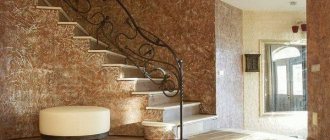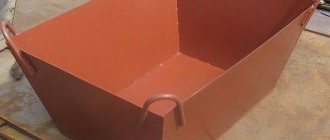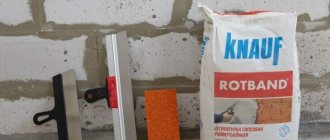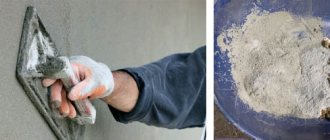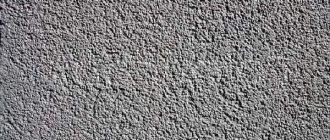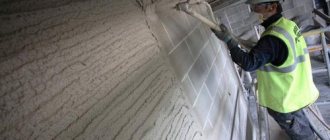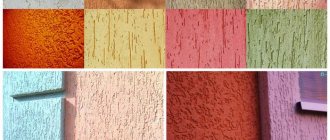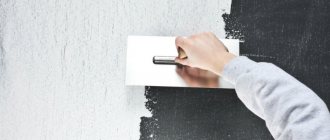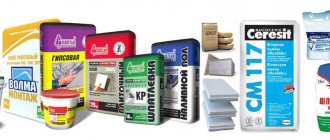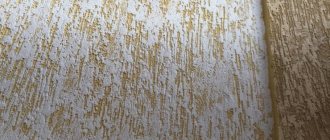The construction and finishing stage is always expensive. The ability to accurately calculate the required number of consumables makes it possible to plan expenses, save time on additional trips to the hypermarket and control their expenditure if the work is not carried out independently. It is difficult to accurately plan the volume of some building materials, and adjustments must be made during construction. The need for others is very easy to calculate, and the time spent on this will pay off in the future. Plaster mixtures belong to the second category, and today’s topic is the consumption of bark beetle plaster per m2, common misconceptions and errors in calculating it.
Photo from stekloholst.com
What is decorative plaster Bark beetle
Bark beetle is a finishing coating for interior spaces and building facades. It got its name because of the original pattern, which looks like tree bark gnawed by small beetles.
Bark beetle is one of the most original and interesting options for decorative plaster.
It is supplied to the market in finished and powdered form. Shades from gray to pure white. In rare cases, the paste is tinted in different colors. The particles added to the composition give it its original texture. Their size varies from 1 to 5 millimeters. The average value is 25 mm.
Among the main advantages of the material:
- environmental friendliness;
- viscosity;
- light weight;
- resistance to mechanical stress;
- resistance to sunlight;
- high vapor permeability;
- wide scope of application;
- affordable price.
One of the main advantages of such plaster is its environmental friendliness.
Among the shortcomings, low maintainability is noted. If a piece breaks off, it is impossible to fix the situation unnoticed. It is also difficult to clean. Dust and dirt gets stuck in the narrow grooves of the pattern, where it is difficult to remove.
Bark beetle is a finishing coating. It involves applying a solution no thicker than the size of the granules included in the paste. It is not recommended to use it to mask various defects: cracks, potholes, chips.
Factors affecting material consumption
The decorative mixture allows you to create an original design with a unique texture. Before installation, experts recommend making a design project that will create an idea of the final result and allow you to calculate how many bags will be needed for the entire room.
Manufacturers of finishing mixtures indicate average consumption on the packaging. However, this parameter is approximate.
Dependence of material consumption on grain size
Material consumption is affected by:
- release form;
- particle size;
- styling technique;
- quality of surface preparation;
- thickness.
The thicker the installation and the more complex the technique, the more plaster will be required for the entire surface. This rule also applies to particle size.
The finer the granules, the smoother the layer and the more economical the work is.
The final consumption of bark beetle plaster per 1 square meter is determined by many factors
Material consumption per square meter
The simplest and most affordable method of wall cladding is leveling them using construction plaster. To carry out finishing activities, it is important to determine how much materials will be needed to successfully carry out the cladding in the house or on the street. Thus, it is necessary to calculate the material consumption per square meter. Moreover, the consumption figure for Rotband plaster per 1 m2 will differ from bark beetle and others.
There are some factors that affect material consumption and which should be taken into account when performing the calculation:
- Curvature of walls that need to be treated with plaster. It is this indicator that determines the amount of material that will be enough to perfectly level the surface.
- Type of building mixture. A certain type of plaster has its own technological consumption standards.
Types of plaster for interior decoration, photos and other data can be viewed and read from this article.
The first step in calculating consumption is to understand the required layer thickness. For these purposes, it is important to thoroughly clean the wall and install beacons using a level. In this way, you can determine points according to which it will be possible to measure surface deviations. After this, take measurements from the plane. The resulting numbers should be added and divided by the number of points. The resulting value will indicate the thickness of the applied bark beetle layer, which can evenly plaster the entire surface of the wall.
To make all this clearer, it is necessary to consider an example. If you need to process 10 m2 of a wall, evenly heaped to 5 cm, and the beacons are installed at 3 points, then the deviations from these points are 2.4 and 6 cm. As a result, you need to sum up the numbers 2+4+6 = 12. Divide the resulting number by 3, it turns out 12_3=4. The resulting figure indicates that the average thickness of the bark beetle plaster layer will be 4 cm.
Warm plaster for interior work, reviews and other technical characteristics can be read in this article.
After this, you need to calculate the consumption rates per 1 m2. As a rule, the packaging contains the necessary information. If you used the Knauf Rotband bark beetle, then on the packaging you will find that to process 12 with a thickness of 10 mm you will need 8.5 kg of dry mixture.
From the article you can learn how to make textured plaster with your own hands.
To understand the consumption of such a composition per 1 m2 and a layer of 4 cm, it is worth multiplying the consumption indicated by the manufacturer by 4 cm. As a result, you get 34 kg. This indicator indicates how much mixture it will take to plaster a 1m2 wall. since the entire area to be treated is 10 m2, you need to multiply 34 by 10. You get a value of 340 kg, which will indicate the required amount of mixture for covering the required wall area.
What is better than drywall or plaster walls can be read in this article.
If you want to know the number of bags with the mixture, then the resulting value of 340 kg should be divided by 30 kg. The last number shows the standard volume of one bag. As a result, you will need to buy 11.33 bags. You need to round the number up. Therefore, to complete the work plan, you must buy 12 bags of bark beetle in the store.
You can read about which gypsum plaster is best to choose for construction in this article.
What type of paint did you purchase?
To calculate the consumption of façade paint per 1 m2, you need to decide what kind of paint will be applied and how well the surface is prepared.
Water-based
The basis of this paint is water in which the pigment floats, which does not dissolve and does not react with the liquid. But after application to the surface, the water evaporates, and that same pigment remains on the wall in the form of a colored film.
The quality of this paint allows it to be used in almost all weather conditions; it tolerates frost, exposure to ultraviolet rays, and protects the surface from moisture.
The facade is painted with water-based emulsion in two layers, the interval between which should be an hour and a half to allow excess moisture to completely evaporate.
Reminder! If the weather outside is below 10 degrees, you will have to postpone it for another hour; in the cold the water does not evaporate well.
You need to buy at the rate of 300 grams per 1m2, that is, for 10m2 you will need 3 liters of paint. The price is reasonable, so there is no need to worry.
Domestic product
Oily
Consists mainly of drying oil, paint pigments and fillers. The latter come either ready-made or purchased in tubes, like a paste. It should be noted that thickly grated ones must be diluted a little before starting work to make painting convenient.
The consumption of finishing material depends entirely on the chosen color, because if you don’t paint red, it will look like pink. It all depends on what shade is required, but the average that buyers use is about 150 grams per 1 m2.
Alkyd
The name comes from the alkyd resins used in paint production. Before application, it must be diluted with kerosene, drying oil, turpentine - each of these substances affects how much paint will be used on the facade. Special impurities that are used to enhance color saturation should also be added to the calculations.
Relevance and benefits
The façade is one of the main impressions made even at a cursory glance. This statement is true for both cozy private houses and commercial skyscrapers. Property owners and architects strive to give it, if not uniqueness, then at least aesthetic appeal. Textured plastering successfully copes with this task by imparting structure, which is complemented by absolute freedom of choice of color shades.
The bark beetle looks organic not only in the exterior, but also in the interior space, which is why it is loved by designers for creative interior ideas for corridors, halls, balconies and even bedrooms.
But still, the impetus for widespread distribution was not so much the beauty of the resulting relief, but rather its pronounced practicality, due to the following:
- Easy to use, thanks to which not only professional builders, but also home craftsmen can cope with plastering;
- Lightness, reducing the load on load-bearing structural elements, especially significant for multi-story buildings;
- Environmental safety achieved by the complete exclusion from technology of toxic substances that can cause poisoning when heated;
- Biological resistance that prevents the development of molds and mosses in the porous structure;
- Heat resistance, maintained for 70 or more freezing cycles and in the temperature range from – 55⁰С to + 60⁰С;
- Immunity to ultraviolet radiation, guaranteeing equal safety on the sunny and shady side in any climate zone, even to the subtropics;
- Long operational period, subject to technical conditions - more than 15 years in indoor spaces and more than 8-9 years in the open air;
- Acid and alkali resistance, allowing wet cleaning, including with non-concentrated detergents;
- Resistant to accidental damage, removing dirt with a brush or vacuum cleaner;
The listed points, combined with maintaining the technological nuances of the process, guarantee durability, as well as resistance to atmospheric and other damaging agents. And the variability of relief formation methods and extraordinary colors create countless combinations for the most demanding customers.
Bark beetle plaster – consumption per 1 m2 of Ceresit brand
This brand represents the products of the German company Henkel on our market and is one of the most popular in the corresponding segment. It should be noted that the range of products includes building mixtures labeled “winter”, intended for low temperature conditions. Let's consider the correlation of material costs with the type of solutions used using this brand as an example.
The polymer cement masses of this company are endowed with both positive and negative characteristics:
- Ease of mixing, creating an easy-to-use homogeneous mass;
- Significant density, making it easy to cover even poorly leveled substrates;
- The manufacturer claims a 10-year service life without the need for restoration manipulations;
- Vapor permeability, preventing condensation at the wall-finish interface;
- Inelasticity, which may cause the finish to crack when the underlying materials expand.
Polymer-cement CeresitCT-35 - sold in 25-kilogram multilayer paper bags in two versions. Composite powder with a grain size of 2.5 mm, according to the data on the packaging, is characterized by a material consumption of 3.2 kg/m². With particles of 3.5 mm, façade plaster bark beetle consumption per m2 will be 4 kg.
Polymer cement dry mixture CeresitCT-36 is packaged in 25 kg bags and contains 2 mm particles. The need for this variety is determined by the pattern (vertical, diagonal, etc.) and ranges from 2 to 4 kg/m².
Acrylic products of this brand are subject to preliminary tinting in tinting machines. Low vapor permeability makes them suitable for finishing facades insulated with foam plastic or expanded polystyrene. After complete hardening, the structure remains elastic and is not subject to cracking or shedding. The disadvantage of this type is its poor dirt-repellent properties, due to which its use near active highways is limited. If the application method is maintained, the service life will be up to 20 years.
Acrylic paste from the German company CeresitCT-64 with a grain size of 2 mm is packaged in plastic buckets of 25 kg. The final cost will be from 2.7 to 3 kg/m², depending on the preparation of the base.
Silicate compounds are also available in paste form, which must be painted using tinting stands. High vapor permeability values do not allow their use on foam plastic or polystyrene foam thermal insulation systems. Its elasticity after hardening makes it even more durable, with an average service life of more than 25 years before the need for restoration manipulation arises. This surface has antistatic properties that do not allow dust and moisture to penetrate the structure. The facade acquires self-cleaning properties under the influence of rain jets.
Silicate CeresitCT-73 requires preliminary application of CeresitCT-15 primer. The product is packaged in 25 kg buckets. The grain size can be 2mm, and then the bark beetle plaster consumption per 1 m2 will be in the range of 2.7-3 kg. If the selected crumb diameter is 3mm, then you will need 4.2-4.5 kg per square.
Silicone plastering solutions are the most practical and functional, and, as a result, the most expensive type. Pigment is also added in tinting machines. The vapor permeability characteristics are similar to those of silicate, and even exceed them in terms of elasticity, mechanical and chemical resistance. The hydrophobic coating is capable of self-cleaning, thanks to which it will retain its pristine cleanliness for the entire service life of 20-25 years.
Silicone CeresitCT-75 is available for sale with grains with a diameter of 2 mm, giving the consumption of decorative bark beetle plaster in the range of 2.7-4.5 kg. You can also find on sale a mass with a particle size of 3 mm and a final cost of 4.2-4.5 kg/m².
After completing the calculations, it is better to increase the obtained figures by approximately 10-15%, since reality almost always exceeds the calculated values. This will help protect against shortages of previously purchased products and repeated trips to the store. However, it’s still not possible to buy with an accuracy of up to a gram, and often the rounding goes to the available packaging.
Consumption per 1m2 depending on the type of bark beetle
Different types of decorative bark beetle plaster differ in composition. Manufacturers distinguish silicate, polymer-cement, acrylic and silicone pastes. Consumption directly depends on the type of material. This is due to differences in structure, plasticity, grain size, and the presence of additional components.
Polymer cement mixture
Polymer-based compositions are easy to apply. They are plastic, have good hiding power, and do not require special surface preparation. One of the significant advantages is vapor permeability.
The main advantages of using polymer-cement compositions are vapor permeability and ease of application.
When calculating, the type of walls and particle size are taken into account. If the granules are 2 millimeters in size, then about 3 kg will be required to finish the surface. With a grain of 4 millimeters - at least 5 kilograms.
Despite its high cost, polymer cement has excellent performance characteristics. The period of use is 10 years. The final cost additionally includes the price for dyes. The surface requires final tinting.
Disadvantages include instability to external factors. With sharp temperature fluctuations, cracking is possible.
Acrylic
Acrylic mixtures have proven themselves well for interior decoration. They are not used for working on the facade of a house. The main advantage of the solution is high elasticity, vapor permeability and cost-effectiveness.
The advantages of acrylic plaster are high elasticity and good cost-effectiveness.
To finish one square meter of prepared base, 3 kilograms of the mixture is enough. If the walls are poorly prepared, more composition may be required. The average service life of the coating is from 15 to 20 years.
Silicate
The silicate mixture is supplied to the market with different grain fractions. Depending on the size of the filler, the consumption of plaster varies:
- Fine filler. Grain no more than 2 millimeters. Consumption per 1 m2 does not exceed 4 kilograms.
- Coarse filler. The composition contains particles up to 3 millimeters. To finish a square meter, up to 5 kg of powder is required.
Silicate compounds are produced with filler granules of different sizes
Among the advantages of silicate solution are high elasticity, vapor permeability, and efficiency.
The composition can act as additional thermal insulation. It does not shrink and is resistant to cracking. Recommended for coating porous substrates (mineral slabs, gas silicate and cellular concrete).
Silicone
The main factors affecting the consumption of silicone mixture are the size of the granules and composition. With particles of 2 millimeters it does not exceed 3 kg, with granules of 4 mm - 5 kg.
High-quality leveling and priming of the base can reduce consumption. Silicone mixtures are elastic, easy to apply, and retain their performance characteristics for a long time. They have shown high efficiency in finishing walls made of cement, gypsum, concrete, foam blocks and aerated concrete blocks.
Silicone plaster is elastic and has a long service life
What primer to use
Currently, the following types of primers can be found on sale:
Adhesive
The name of this group of primers speaks for itself - they are designed to improve adhesion. Therefore, adhesive primers must be applied to smooth surfaces such as concrete.
Adhesion is enhanced by the presence of fine abrasive in the primer. For those, the base after priming becomes rough, like sandpaper. Thanks to this, decorative plaster holds well.
Most often, sand or needle quartz is used as an abrasive. Those primers are essentially a water-based binder (adhesive) filled with solid mineral particles.
Quality soil Knauf – betokontakt
Price:
Advantages and disadvantages
Advantages:
We have already mentioned many:
- resistance to temperature changes: bark beetle does not lose its properties at temperatures from –55 to +60 C, it does not fade, does not erode, and does not get wet in the rain. Bark beetle can be used as a finishing layer in thermal insulation systems.
- with its help you can hide minor defects on the walls.
- resistance to mechanical damage. The plaster will not crumble from an accidental blow, and even the most harmful cat will not scratch such a coating in the apartment.
- resistance to aggressive environments (acids, alkalis and industrial gases).
- high vapor permeability, the house will not be clogged, it will “breathe”.
- possibility of restoration of architectural monuments (mainly with silicate plasters).
- environmental Safety.
- durability. The manufacturer guarantees the service life of some compounds up to 25 years.
- the ability to repaint the surface in any color.
- Easy to maintain: even unpainted surfaces can be washed, brushed or vacuumed.
Learning to make a pattern on a bark beetle
Having found out how much bark beetle plaster we need per 1 m2, we move on to methods of applying drawings and patterns to the surface. Using a grater, we level the plaster: the character of the pattern depends on our movements.
If you make clear vertical movements, you get a rain pattern. In the case of direct horizontal movements of the tool, stripes will begin to appear.
The frosty pattern is created by wave-like movements of the hand. By rubbing the surface of the wall with a polystyrene foam trowel, you can make a “cork” if you move your hand in a circle using a small amplitude.
In 70–80 hours, the decorative bark beetle plaster will dry perfectly. Open windows and doors are absolutely excluded, as there should be no draft. After the surface has dried, apply varnish to the plastered walls or paint them in the desired color. The paint consumption is indicated on the can.
Wall application
Calculation
As mentioned above, the consumption of Bark Beetle plaster per 1 m2 largely depends on the size of the granules. Despite this, there is some average figure. On average, it can take from 2.4 to 10 kilograms per square meter. The thickness of the layer is also taken into account.
In addition, the technology for manufacturing the substance varies from manufacturer to manufacturer. Therefore, the best option would be to take into account the data indicated on the packaging. In this case, you need to add about 10 percent on top.
As an illustrative example, let’s take a plaster layer 10 mm thick. To apply it to the wall, you will need at least 6-7 kilograms of bark beetle. Provided that the producer is Volma.”
But if you take decorative plaster “Bark Beetle” as a consumable material and calculate the consumption per 1 m2 for the same layer, it will be about 9 kg. Simply put, if you want to decorate a 30 m2 room, you will need about 270 kg.
Consumption per 1m2 depending on the manufacturer
The amount of finishing solution directly depends on the type of material and the size of the granules. However, the composition may differ between manufacturers. Accordingly, finishing costs will also be different. To evaluate them, you should carefully study the information about the product indicated on the packaging.
The consumption of decorative bark beetle plaster per 1m2, depending on the manufacturer, is as follows:
- Volma – 6.5 kg;
- Prospectors – 9 kg;
- Ceresite – 3 kg;
- Ceresit ct 35 Bark beetle – 4 kg;
- Knauf Rotband – up to 8 kg.
Ceresit silicone solutions have slightly higher consumption than polymer solutions. It can reach up to 5 kilograms per square meter. The increase is influenced by improper storage and dampness of the solution, temperature and humidity in the room during work.
Improper storage of silicone plaster can cause high consumption of finishing solution
What factors need to be taken into account
The consumption of decorative bark beetle plaster per square meter is planned taking into account the following factors:
- condition of the surface to be treated (the wall is flat or has cracks, chips);
- degree of readiness for applying the plaster mixture (rough or pre-finishing preparation);
- size of granules of mineral composition;
- level of curvature of the wall panel;
- type of plaster (powder or paste consistency);
- one- or two-component mixture composition;
- type of surface to be treated (for interior or exterior work);
- planned thickness of the plaster layer;
- storage conditions for the finishing mixture in warehouses;
- technique of applying the product to the wall;
- temperature and humidity level in the room when plastering surfaces;
- The consumption is affected by the experience of the master, etc.
How does the consumption of façade material depend on the type of mixture?
The consumption of decorative bark beetle plaster per 1 m2 is calculated taking into account the quality characteristics of the finishing material. The work uses polymer, acrylic, silicate and silicone plasters. Materials differ in structure, texture, size of filler granules, etc.
You can reduce the cost of plaster composition by carefully leveling the surface and covering the walls with an insulating primer. The porous structure of the walls increases the degree of absorption and consumption of the finishing mixture. Surface treatment also improves adhesion. A primed base will increase the reliability of the finish and extend its shelf life.
Polymer composition
Polymer plaster is easy to apply, does not require careful preparation of the panels, and has good vapor permeability. The volume of required material per m² of surface is calculated taking into account the size of the filler fractions. If there are particles with a diameter of 2.5 mm in the building mixture, at least 3 kg of plaster mortar will be required, and 4.5 mm - up to 4 kg.
The material has a long service life (10 years). It is necessary to take into account that dyes will be included in the cost plan, because... the coating will need to be tinted. You need to know that the material is not used in rooms with frequent changes in temperature conditions, because... elasticity is average and cracks may form due to temperature changes.
Acrylic plaster
For acrylic plaster, the consumption of bark beetle is determined taking into account the technical characteristics of the finishing material. The mixture is used for interior finishing work and is not used when decorating facades. This type of plaster has high elasticity, low vapor permeability, and is economical.
The average consumption of bark beetle plaster per 1 m2 when applied to a prepared, leveled surface is 3 kg.
Silicate mixture
Silicate plaster is produced with filler granules of different sizes; this indicator determines the amount of mixture consumed when finishing the premises. When using a plaster mortar with particles with a diameter of up to 2 mm, 3 kg per 1 m² will be required, 3 mm - 4.5 kg for the same area.
The advantage of silicate material is its high elasticity and vapor permeability. The technical characteristics of the plaster composition ensure economical use of the product. The shelf life of the coating is from 20 years. The material is a good heat insulator and does not shrink during the drying process. The product is resistant to chemical cleaning solutions and can withstand temperature changes.
The consumption of silicate plaster may vary, since the material contains liquid glass, plasticizers, coloring pigments and different types of fillers. Sand, cement powder, mineral particles, etc. are used as thickeners.
When working, take into account the technical characteristics of the plaster:
- density level is 1800 kg/m³;
- the composition is applied at a temperature of +5…+30°С;
- adhesion level - 0.6 MPa;
- frost resistance - up to 100 cycle changes;
- the mixture is diluted with water;
- good adhesion to fibreboards, plasterboard, concrete.
Silicone solution
For silicone bark beetle plaster, the consumption per 1 m2 is determined by the composition and size of the filler granules. If there are particles with a diameter of 2 mm, up to 3.5 kg of solution per 1 m² is required; for larger fractions, up to 4.5 kg of building mixture will be required for a given area.
When making calculations, it is necessary to take into account the need for leveling and priming the base for economical use of the composition. The material is elastic, has a long service life while maintaining the aesthetics of the coating (more than 25 years), and is vapor permeable.
When calculating, the technical characteristics of the composition are taken into account:
- the grain level is 1.5-3 mm;
- application at temperature +5…+30°С;
- frost resistance level - up to 100 cycles;
- complete drying - within 2 weeks;
- Setting of the mass when creating texture is 15 minutes.
The plaster is suitable for application to cement, gypsum or concrete bases, foam blocks, lime surfaces, aerated concrete blocks.
Kinds
The marble chips contained in the bark beetle are only an additive . Like any other plaster, bark beetle can have a different base: acrylic, silicone, silicate, mineral... The price of the plaster and its consumption depend on the base composition.
The cheapest are cement-based dry mixtures, usually applied before painting.
Mineral plasters based on cement-sand mortars are more stable than cement plasters and are often used for external thermal insulation.
Acrylic compositions based on acrylic resins have a service life of 15-25 years and are even more expensive.
Silicate plaster is plastic and antistatic, it repels dust and is easy to clean - accordingly, this is the next step in prices. Find out about finishing putty for facade work here.
Vapor-permeable and non-salt-absorbing silicone plasters are currently the most technologically advanced, but also the most expensive.
Cement and mineral plasters are sold in the form of dry mixtures. Acrylic, silicate and silicone are ready-to-use paste mixtures sold in plastic buckets. The most common packaging is 25 kg.
Consumption depending on grain size
The bark beetle is supplied to the market with different labeling. This indicator indicates the size of the filler particles. In most cases it can vary from 2 to 4 millimeters.
Before starting work, it is necessary to study in which cases which markings of the solution are tried on. Finely granular mortars are suitable for finishing interior walls. They provide a smoother and more decorative layer, are flexible and economical. Consumption is no more than 2.5 kilograms per 1m2.
Finely granulated solutions are used for interior wall decoration.
Coarse-grained mixtures with granules up to 4 millimeters are more expensive. To cover 1 square meter you will need up to 4 or more kilograms of dry powder. Such solutions are used in finishing the facades of buildings and structures.
The characteristics of some compositions are given in the table.
| Name | Granule size, mm | Consumption, kg/m2 | Color | Application temperature | Type of packaging |
| Color-Plast SK "Bark Beetle" | 1,5 | up to 2.8 | 56 basic colors + 2500 color shades Tikkurila MONICOLOR nova | From +5 to +30 degrees | Plastic bucket, 30 kg |
| 2,0 | up to 3.2 | ||||
| 3,0 | up to 4 | ||||
| Color-Plast Ssh “fur coat”, manual application | 0,5 | 1,8 | |||
| 1,0 | 2,3 | ||||
| 2,0 | 3,0 | ||||
| 3,0 | 4,0 | ||||
| 1,0 | 3,0 | ||||
| 2,0 | 4,0 | ||||
| Color-Plast L, manual application | 1,5 | 3,5 | 56 basic colors | ||
| 2,0 | 5,0 |
Marking
The correct choice of marking determines the consumption of façade plaster.
Using grains of a certain size in the original version allows you to better understand where it is best to use the decorative mixture.
Small grains are used in the mixture for internal repairs. Large gypsum granules are suitable for external use on facades. The main thing to remember is that the greater the number of grains in the beetle bark component increases the amount of material for the building wall. With a particle size of 2 millimeters per 1 meter of partition, it will take about 2.5 kilograms.
Material
Tips for choosing material
If you want to plaster the walls with the presented coating option, you should make the right choice of material. The choice of plaster determines the application and implementation of all stages of decoration. Use the selection tips below:
- Pay attention to the characteristics of the composition; it is best to choose a material with good adhesion and moisture resistance.
- Compositions based on silicate and silicone polymers are best suited for the job.
- The combination of price and quality should be optimal, but you should not give preference to cheaper options.
- The larger the size of the granules, the greater the consumption, this should be taken into account when calculating the required amount of material.
Pattern with circular movements of the trowel
Typical errors when applying the mixture
After the required consumption per 1 m2 of wall has been calculated and the specifics and subtleties of applying texture to the surface part of the wall have been studied, we will focus on the most common mistakes when working with bark beetles:
- uncleaned wall surface. Although the decorative mixture has very good adhesion, the possibilities are still not unlimited. Therefore, if the mixture is applied to an old finishing coating, cracks may appear on the surface in the future. All this happens because different types of finishes react differently to room temperature;
- non-compliance with the temperature regime in the room during the stage of application and complete drying of the decorative bark beetle. The permissible temperature is from +5 to +30 °C.
Before going to a specialized store to buy plaster, you must first measure the surface of the future work, set beacons, calculate the curvature and consumption of the product per 1 m2.
Let's take a calculator and, following the above formulas, calculate the exact number of bags of textured powder mixture and other costs. And don’t lose sight of the notorious 10% for reserve.
Source
Painting the walls
Having figured out which paints are best suited and having assessed the scale of the entire action, you can safely proceed to the first stage of repair work.
The variety of colors is limitless
Surface preparation
In any façade work, it is very important to properly prepare the surface, with the exception of ventilated systems.
- If the walls are made of concrete, the most important thing is to clean it from dirt and dust. After which it is necessary to seal all the holes and cracks and allow to dry.
- The same thing applies to the plastered surface of facades; the main thing is to keep it clean and dry - then the paint will adhere better.
- When working on a surface that has already been painted, you should remove all the old façade finishing by cleaning and sanding: the paint does not stick well to itself.
- When painting metal elements, be sure to remove traces of rust, even barely noticeable ones.
- After everything is cleaned and puttied, the surface is primed.
Note! Corrosion, fungi, rust and mold significantly increase the consumption of acrylic facade paint, since in contaminated areas it will more often crack and peel, requiring repair.
Finishing work
When starting to directly apply paint to the surface, you should take into account several nuances that may affect the result:
- The ambient temperature should not be below 5 degrees.
- It is not advisable to carry out work after rain, or you will have to wash it and wait until the surface dries.
- You need to purchase a new brush or roller; working with a tool that has already been in contact with paint is contrary to the norm. The photo below shows a conveniently used roller.
Roller on an extended handle Expert advice:
- The layers must be applied perpendicular to each other: if the first layer of paint was applied horizontally, then the second should be vertical.
- You should wait until the first layer dries, otherwise the paint may wrinkle.
- Try to avoid windy days, which raise dust into the air, which, in turn, settles on the facing material.
Painting instructions:
- Start work from the top of the facade so that the fresh paint does not run off onto the already drying layer.
- After dipping the roller into the container with paint, slowly begin to move it across the surface, lightly pressing on the base.
Special container for paint
- It is better to use a wide brush to cover a larger area at a time.
- After applying the paint, evaluate the result; if it is visible in some places, you will have to apply a third layer.
Use several types of brushes: for joints, corners and other facade elements
Important! In this situation, the material consumption will increase: you will either have to buy more or leave it as it is.
How to save money
Savings are only possible when you understand what influences the increase in consumption.
The main parameters influencing the cost of the solution are:
- layer thickness;
- application technology;
- grain size;
- quality of base preparation.
The consumption of decorative mortar depends on the thickness of the layer applied to the walls
If the first 3 parameters cannot be changed, then it is possible to save significantly on the last one. Porous walls actively absorb moisture and increase the consumption of decorative mixtures. Therefore, all surfaces must be carefully prepared.
It is important to measure elevation differences and level them out as much as possible. The smooth surface allows you to apply a minimum thickness of the plaster layer.
To minimize absorption, the base is primed with deep penetration compounds. They create a polymer film that prevents water from entering the walls from the plaster. Thanks to this, the finish adheres more firmly.
To reduce solution costs, the surface must be leveled
The last rule of saving is careful calculation. You should calculate in advance the amount of material required. For finishing it is purchased with a small reserve. It should not exceed 10-15% of the calculated value.
Is it necessary to prime the base before the bark beetle?
Priming the surface before applying the finishing material is carried out in order to improve the adhesion of the building mixture to the base. After treatment, the wall does not absorb liquid. When the master begins to apply the mixture, moisture does not leave it. This allows the bark beetle to be evenly distributed over the wall, preventing the material from rolling. The improved interaction of the finishing composition with the treated base further helps reduce the financial costs of purchasing the former. Any solution that has fallen to the ground cannot be used.
If the base is loose and porous, then the primer will increase the strength of the surface layer. Bark beetle applied to an untreated wall will not last long. It may crumble during operation, i.e. even before full setting occurs. The primer will strengthen the wall and prevent part of the applied finishing material from peeling off along with a fragment of the base.
The water-repellent properties of the primer will provide protection from the destructive effects of precipitation. Thanks to this, the façade of the building will retain its technical and heat-insulating characteristics. Also, the waterproofing and antibacterial properties of the primer will prevent the appearance and proliferation of fungal microflora.
Short description
The original texture corresponds to the name of the finish - decorative bark beetle plaster, which is achieved using the components included in the construction mixture.Component
Variety of components
Cement with polymer elements
Resin mixtures based on polymer components such as acrylic, latex or silicone
Consists of marble material. The proportions of the grain affect the depth of the grooves; the larger its diameter, the deeper the grooves will be.
The sizes of marble chips are indicated on the packaging, on average they range from 0.1 to 3.5 mm
The technical features of the material depend on the type of binder components.
The grain, in turn, creates uneven and asymmetrical depressions during the process of applying the material to the wall.
Bark beetle plaster, in addition to the main components, contains mineral mixtures and various additional materials that improve the characteristics of the cladding. This factor indicates that a product of the same name may have significant differences in technical characteristics and appearance. Therefore, in order to achieve the desired result during the repair process, you should study all existing types and features of building materials.
Tinting
Painting plaster creates an additional protective layer, which is especially important for facades.
With the help of a color scheme, you can create new color compositions without redoing the entire renovation.
Features of painting textured surfaces include the difficulty of filling grooves and depressions in the plaster.
There are three ways to paint finished bark beetle plaster:
- Lighter acrylic or silicone paint is applied to the surface finished with bark beetle. In this case, the consistency of the color should be thick enough so as not to flow into the textured furrows. The furrows remain their original color.
Figure 11. Painting the surface of the plaster.
- Add color to latex primer. Thanks to the liquid primer, all the recesses and pores of the plaster are painted. After the primer has dried, the wall is covered with another layer of paint, which, in combination with the primer, provides durable and reliable protection from moisture and external influences.
Figure 12. Painting plaster.
- The finished plaster is coated with a transparent matte or glossy varnish. Varnish makes the color deeper and more saturated and creates additional protection.
Figure 13. Varnish coating of bark beetle plaster.
TOP 3 best products according to customers
Application technology
We will not provide here detailed instructions on how to plaster with bark beetle. Let us note only a few subtleties.
- Bark beetle plaster is applied to almost any surface: brick, concrete, cement-sand plaster, gypsum, chipboard, polystyrene (foam) and plywood.
- It is not recommended to apply bark beetle to flexible surfaces and smooth synthetic structures (plastic, varnish and oil coatings, fresh lime and adhesive plasters).
- The walls must be clean, smooth and pre-treated with primer paint. It is better to choose it the same color as your plaster, otherwise darker areas of the base may show through the thin layer of bark beetle.
- As with any construction work, it is better to use all materials from one manufacturer. Strictly adhere to the drying time of previous layers of plaster.
- The plaster dries quickly - do not dilute a large amount of the mixture at once. To avoid visible joints between sections of work completed at different times, stop at architectural details (protrusions, corners, drainage pipes, etc.).
- The optimal area for simultaneous application of plaster is 1.5-2 m². After 15-20 minutes, it will be difficult to correct defects in the plaster and apply “bark beetle tracks.” Do not try to trace the paths several times - the more you “smooth” the surfaces, the less the effect will be.
- When working outdoors, try to avoid extremely hot or rainy days. The plaster dries quite quickly, 4-6 hours, but it takes at least 24 hours to completely dry and acquire the desired properties. Until this time has expired, it is advisable to protect surfaces from sun and rain.
- Dried plaster (drying time is at least 6 hours!) can be painted.
Technology for working with this material
Applying Bostrico plaster to the wall
The bark beetle is applied to a leveled surface that is well-primed, which will increase the adhesion of the material and the base.
If there are significant differences and grooves on the walls, it is necessary to use leveling putty, which will allow the base to be properly prepared.
You need to work with the bark beetle carefully and at the same time quickly. This plaster consists of concrete, so it hardens quickly. Literally 15-20 minutes after preparing the plaster, it becomes impossible to work with such a cement material.
It should be applied to the walls with a spatula and leveled with a special metal spatula. After hardening, the walls must be treated with a special roller and cleaned with a bark beetle grater.
Methods and examples of flow calculation
A preliminary calculation allows you to estimate the volume of packaging required per room. First, study the base - if it is flat, then the thickness of the coating will be minimal.
The smooth surface allows you to apply a minimum thickness of the plaster layer
Consumption is estimated using the formula: A*B*C, where A is the average consumption of the mixture per 1 m2, B is the surface area for application, C is a layer of plaster 1 centimeter thick. To finish 19 square meters, with a consumption of 6 kg, you will need 6 * 19 * 1 = 114 kilograms. Most manufacturers pack 25 kg bags. The final value will be 4.56 bags. Masters recommend taking with a margin of 10-15%. Therefore, in this case, at least 5 bags will be required.
If the base has differences, control measurements are taken at several points. Their values are added and divided by the quantity. The average layer thickness is obtained. With differences of 3, 6 and 7 cm, the average layer thickness will be at least (3+6+7)/3=5.4 centimeters. Further, to calculate the bark beetle plaster, similar operations are carried out as indicated above.
Calculation of the amount of mixture
In addition to purely technical (granulometry in plaster) or physical (worked surface) characteristics, material consumption can be influenced by:
- workplace: in any case, the cost of external work will be greater than that of internal work;
- preliminary preparation of the wall (roughness, unevenness, etc.);
- qualification of the craftsman - an experienced craftsman minimizes unproductive losses: rework, remaining mixture in the container, solution falling to the ground, etc.;
- operating conditions: house close to roads, dusty area, weather conditions. An unfavorable climate requires increased consumption of gypsum.
Therefore, to calculate the amount of materials it is necessary to take into account:
- calculated thickness of the plaster layer. A layer that is too thick cannot be pushed through to get a pattern, so count to the minimum;
- surface - do not forget to take into account all corners, niches and reliefs, if this is a building with complex architecture;
- builder's skill.
After this, add another 10% to the amount received - the usual reserve in case of unforeseen difficulties. Since almost all companies produce mixtures in 25 kg packages, special accuracy in calculations is not required.
Facade paints and their consumption
Most Bark Beetle finishing plasters are supplied to the market in white. In rare cases they are already tinted. They can be given a tint by introducing a color pigment into a ready-made solution for plastering walls or covering them with façade paint.
You can give the decorative solution the desired color using coloring pigments.
Painting after complete drying of the finish showed high efficiency. For work, craftsmen use a soft roller without strong pressure. This technique allows you to avoid painting the depressions, which gives the surface a three-dimensional volume.
The following paints showed high efficiency:
- acrylic;
- alkyd;
- silicate;
- silicone;
- oil
When using acrylic materials per square meter, up to 200 grams in 2 layers is required. The paints are suitable for finishing interior rooms. When working with facades, dyes that are resistant to external factors are selected.
When tinting the surface with acrylic paint in 2 layers, you will need 200 g per 1 m2
For silicone and silicate paints, consumption ranges from 300 to 400 grams per 1 m2 with double application. Oil pigments are the most economical, but they are vapor permeable and easy to ignite.
The technical specifications indicated on the product packaging allow you to calculate how much dye is needed to tint the walls. To calculate, multiply the indicator on the packaging by the wall area and the number of layers.
Mechanisms and tools
Basic tools and mechanisms for applying the bark beetle finish:
- a hammer drill with a power of at least 1200 W, with a nozzle for stirring the solution or a construction mixer;
- a brush or roller for priming and painting plaster when using untinted mortar;
- metal spatula 100 mm wide, for scooping mixture from container;
- steel trowel for distributing the plaster mixture;
- plastic grater for applying textured patterns;
Figure 6. Tools for creating bark beetle plaster.
Preparing the surface for work
After purchasing materials, they proceed to preparatory operations. The final result directly depends on the quality of the walls. Work order:
| 1. Surfaces are thoroughly cleaned of old coating. Remove existing dirt, construction bolts, and other defects. If there are cracks, they are cleaned out. |
| 2. If signs of fungus or mold are found, they are cleaned as much as possible, and the detection areas are treated with antiseptics. |
| 3. Then apply deep penetration primer. |
| 4. If the difference is more than 2-3 millimeters per square meter, then preliminary leveling is done. The solution is used to seal cracks and irregularities. If local bulges are present, they are cut off with a grinder. |
| 5. The leveled surface is re-primed. |
According to experts, the permissible difference should not exceed 1 millimeter. When the preparatory stage is completed, they begin to knead the material and apply it.
